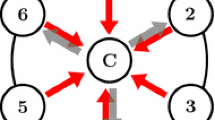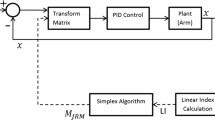Abstract
The leading joint hypothesis (LJH), developed for planar arm reaching, proposes that the interaction torques experienced by the proximal joint are low compared to the corresponding muscle torques. The human central nervous system could potentially ignore these interaction torques at the proximal (leading) joint with little effect on the wrist trajectory, simplifying joint-level control. This paper investigates the extension of the LJH to spatial reaching. In spatial motion, a number of terms in the governing equation (Euler’s angular momentum balance) that vanish for planar movements are non-trivial, so their contributions to the joint torque must be classified as net, interaction or muscle torque. This paper applies definitions from the literature to these torque components to establish a general classification for all terms in Euler’s equation. This classification is equally applicable to planar and spatial motion. Additionally, a rationale for excluding gravity torques from the torque analysis is provided. Subjects performed point-to-point reaching movements between targets whose locations ensured that the wrist paths lay in various portions of the arm’s spatial workspace. Movement kinematics were recorded using electromagnetic sensors located on the subject’s arm segments and thorax. The arm was modeled as a three-link kinematic chain with idealized spherical and revolute joints at the shoulder and elbow. Joint torque components were computed using inverse dynamics. Most movements were ‘shoulder-led’ in that the interaction torque impulse was significantly lower than the muscle torque impulse for the shoulder, but not the elbow. For the few elbow-led movements, the interaction impulse at the elbow was low, while that at the shoulder was high, and these typically involved large elbow and small shoulder displacements. These results support the LJH and extend it to spatial reaching motion.







Similar content being viewed by others
Notes
Movement at different speeds is not endemic to the discussion of the LJH. This feature of the experiment was included to evaluate the Time Invariance Hypothesis (Ambike and Schmiedeler 2006), which is not part of this paper.
For a planar arm model, all joint torque vectors are normal to the arm’s movement plane. Therefore, the torques in Eq. 2 appear as scalar magnitudes in the cited studies. In contrast, NT, MT, IT, and GT generally represent vector quantities in this paper, unless stated otherwise.
The elbow joint variable is defined as the angle between the forearm and the upper arm.
References
Abend W, Bizzi E, Morasso P (1982) Human arm trajectory formation. Brain 105:331–348
Ambike S, Schmiedeler JP (2006) Modeling time invariance in human arm-motion coordination. In: Lenarčič J, Roth B (eds) Advances in robot kinematics. Springer, Dodrecht, pp 177–184
Ambike SS (2011) Characteristics of spatial human arm motion and the kinematic trajectory tracking of similar serial chains. Dissertation, The Ohio State University
Atkeson CG, Hollerbach JM (1985) Kinematic features of unrestrained vertical arm movements. J Neurosci 5:2318–2330
Bernstein NA (1967) The coordination and regulation of movement. Pergamon, New York
Buchanann JJ (2004) Learning a single limb multijoint coordination pattern: the impact of a mechanical constraint on the coordination dynamics of learning and transfer. Exp Brain Res 156:39–54
Dempster WT, Gaughran GRL (1967) Properties of body segments based on size and weight. Am J Anat 120:33–54
Dounskaia N (2005) The internal model and the leading joint hypothesis: implications for control of multi-joint movements. Exp Brain Res 166:1–16
Dounskaia N, Ketcham CJ, Stelmach GE (2002) Commonalities and differences in control of various drawing movements. Exp Brain Res 146:12–25
Dounskaia NV, Swinnen SP, Walter CB, Spaepen AJ, Verschueren SMP (1998) Hierarchical control of different elbow-wrist coordination patterns. Exp Brain Res 121:239–254
Feldman AG (1986) Once more for the equilibrium point hypothesis (λ model). J Mot Behav 18:17–54
Feltner ME, Dapena J (1989) Three-dimensional interactions in a two-segment kinematic chain. Part 1:general model. Int J Sports Biomech 5:403–419
Flanders M, Herrmann U (1992) Two components of muscle activation: scaling with the speed of arm movement. J Neurophysiol 67:931–943
Gagnon D, Gagnon M (1992) The influence of dynamic factors on triaxial net muscular moments at the L5/Sl joint during asymmetrical lifting and lowering. J Biomech 25:891–901
Galloway JC, Koshland GF (2002) General coordination of shoulder, elbow and wrist dynamics during multijoint arm movements. Exp Brain Res 142:163–180
Galloway JC, Bhat A, Heathcock JC, Manal K (2004) Shoulder and elbow joint power differ as a general feature of vertical arm movements. Exp Brain Res 157:391–396
Goble JA, Zhang Y, Shimansky Y, Sharma S, Dounskaia NV (2007) Directional biases reveal utilization of arm’s biomechanical properties for optimization of motor behavior. J Neurophysiol 98:1240–1252
Greenwood DT (1988) Principles of dynamics. Prentice Hall, New Jersey
Gribble PL, Ostry DJ (1999) Compensation for interaction torques during single and multijoint limb movement. J Neurophysiol 82:2310–2326
Hirashima M, Kudo K, Ohtsuki T (2007) A new non-orthogonal decomposition method to determine effective torques for three-dimensional joint rotation. J Biomech 40:871–882
Hirashima M, Kudo K, Watarai K, Ohtsuki T (2007) Control of 3D limb dynamics in unconstrained overarm throws of different speeds performed by skilled baseball players. J Neurophysiol 97:680–691
Hollerbach JM (1982) Computers, brains, and the control of movement. Trends Neurosci 6:189–192
Hollerbach JM, Flash T (1982) Dynamic interactions between limb segments during planar arm movement. Biol Cybern 44:67–77
Hore J, Debicki DB, Gribble PL, Watts S (2011) Deliberate utilization of interaction torques brakes elbow extension in a fast throwing motion. Exp Brain Res 211:63–72
Karst GM, Hasan Z (1991a) Initiation rules for planar, two-joint arm movements: agonist selection for movements throughout the work space. J Neurophysiol 66:1579–1593
Karst GM, Hasan Z (1991b) Timing and magnitude of electromyographic activity for two-joint arm movements in different directions. J Neurophysiol 66:1579–1593
Kawato M (1999) Internal models for motor control and trajectory planning. Curr Opin Neurobiol 9:718–727
Ketcham CJ, Dounskaia N, Stelmach GE (2004) Age-related differences in the control of multijoint movements. Motor Control 8:422–436
Levin O, Ouamer M, Steyvers M, Swinnen SP (2001) Directional tuning effects during cyclical two-joint arm movements in the horizontal plane. Exp Brain Res 141:471–484
Murray RM, Li Z, Sastry SS (1994) A mathematical introduction to robotic manipulation. CRC Press LLC, Florida
Sainburg RL, Ghez C, Kalakanis D (1999) Intersegmental dynamics are controlled sequential anticipatory, error correction, and postural mechanisms. J Neurophysiol 81:1045–1056
Sainburg RL, Ghilardi MF, Poizner H, Ghez C (1995) Control of limb dynamics in normal subjects and patients without proprioception. J Neurophysiol 73:820–835
Sainburg RL, Kalakanis D (2000) Differences in control of limb dynamics during dominant and nondominant arm reaching. J Neurophysiol 83:2661–2675
Schneider K, Zernicke RF (1990) A FORTRAN package for the planar analysis of limb intersegmental dynamics from spatial coordinate-time data. Adv Eng Softw 12:123–128
Schneider K, Zernicke RF, Ulrich BD, Jensen JL, Thelen E (1990) Understanding movement control in infants through the analysis of limb intersegmental dynamics. J Mot Behav 25:521–535
Soechting JF, Lacquaniti F, Terzuolo CA (1986) Coordination of arm movements in three-dimensional space. Sensorimotor mapping during drawing movement. Neuroscience 17:295–311
Spong WM, Hutchinson S, Vidyasagar M (2006) Robot modeling and control. Wiley, USA
Todorov E (2004) Optimality principles in sensorimotor control. Nat Neurosci 7:907–915
Vandenberghe A, Levin O, De Schutter J, Swinnen S, Jonkers I (2010) Three-dimensional reaching tasks: effect of reaching height and width on upper limb kinematics and muscle activity. Gait Posture. 32:500–507
Veeger HEJ (2000) The position of the rotation center of the glenohumeral joint. J Biomech 33:1711–1715
Virji-Babul N, Cooke JD (1995) Influence of joint interactional effects on the coordination of planar two-joint arm movements. Exp Brain Res 103:451–459
Winter DA (2005) Biomechanics and motor control of human movement. Wiley, New Jersey
Wua G, van der Helm FCT, Veeger HEJ, Makhsouse M et al (2005) ISB recommendation on definitions of joint coordinate systems of various joints for the reporting of human joint motion. Part II: shoulder, elbow, wrist and hand. J Biomech 38:981–992
Yadav V (2010) Validation of a time-scaling-based model for representation of dynamics in humans and its applications in rehabilitation. Dissertation, The Ohio State University
Zajac FE, Gordon ME (1989) Determining muscle force and action in multiarticular movement. Exerc Sports Sci Rev 17:187–230
Zatsiorsky VM (2002) Kinetics of human motion. Human Kinetics, Champaign
Acknowledgments
Support was provided by grant no. IIS-0937612 from the National Science Foundation. The authors wish to thank Mr. Julian Corona for his assistance with the data collection.
Author information
Authors and Affiliations
Corresponding author
Appendix
Appendix
The analytical expressions for the net, interaction, and muscle torques for the shoulder and elbow joints developed in Ambike (2011) are provided here. The thorax is assumed to be stationary. The elbow is modeled as a single-DOF revolute joint with the rotation axis along the Z axis of the coordinate frame fixed in the upper arm, as recommended by the ISB protocol (Wua et al. 2005). The shoulder is modeled as a ball-and-socket joint allowing three degrees of rotational freedom for the humerus. The glenohumeral center was assumed as the joint center. The wrist joint is ignored. The hand is incorporated as a point mass at the end of the forearm, as seen in Fig. 8. The mass and center of mass of the combined ‘forearm-hand’ are computed and used in the torque calculations. In Ambike (2011), the development in Feltner and Dapena (1989), Gagnon and Gagnon (1992), Winter (2005) is modified by introducing movement of the forearm relative to the upper arm.
Figure 8 shows the global coordinate frame, frames attached to the forearm (F) and upper arm (U), and the free body diagrams of the arm segments. All variables are defined in Table 3. For a vector quantity, the leading superscript indicates the coordinate frame in which the vector is expressed, but the superscript is omitted for the global frame. The Newton–Euler approach (Winter 2005) for developing the equations of motions is more suitable than the Lagrangian approach (Greenwood 1988) for implementing the partitioning scheme outlined in "Data recording and analysis". Newton’s second law applied to each segment yields the joint reaction forces, \(\overline{R}_E\) and \(\overline{R}_F\), at the elbow and the shoulder, respectively. The partitioning scheme is first applied to the reaction forces to obtain reaction components that can be attributed to motions of only the elbow (\(\overline{R}_{EF}, \overline{R}_{SF}\)), only the shoulder (\(\overline{R}_{EU}, \overline{R}_{SU}\)), both joints (\(\overline{R}_{Eint}, \overline{R}_{Sint}\)), and gravity (\(\overline{R}_{Eg}, \overline{R}_{Sg}\)).
where
Similarly, for the shoulder joint,
where
Two applications of Euler’s equation yield the net, interaction, and gravity torques at the elbow,
and at the shoulder,
Rights and permissions
About this article
Cite this article
Ambike, S., Schmiedeler, J.P. The leading joint hypothesis for spatial reaching arm motions. Exp Brain Res 224, 591–603 (2013). https://doi.org/10.1007/s00221-012-3335-x
Received:
Accepted:
Published:
Issue Date:
DOI: https://doi.org/10.1007/s00221-012-3335-x





